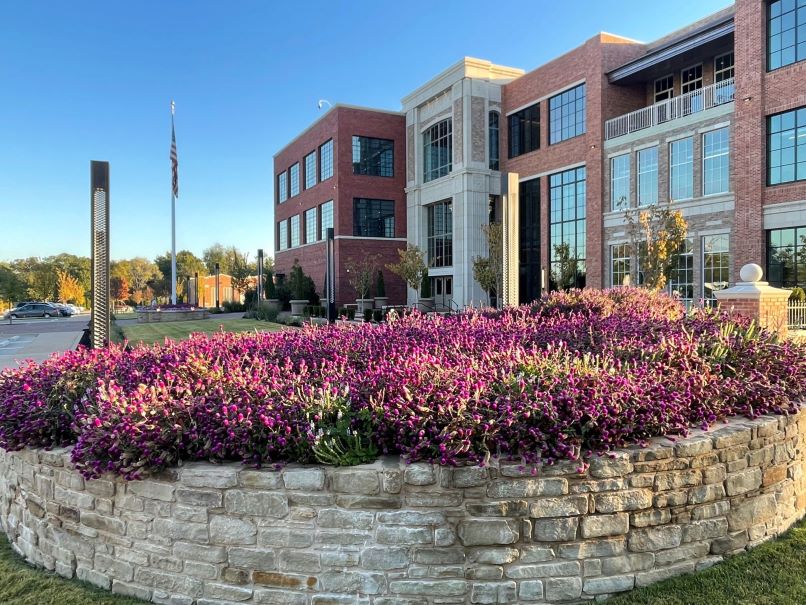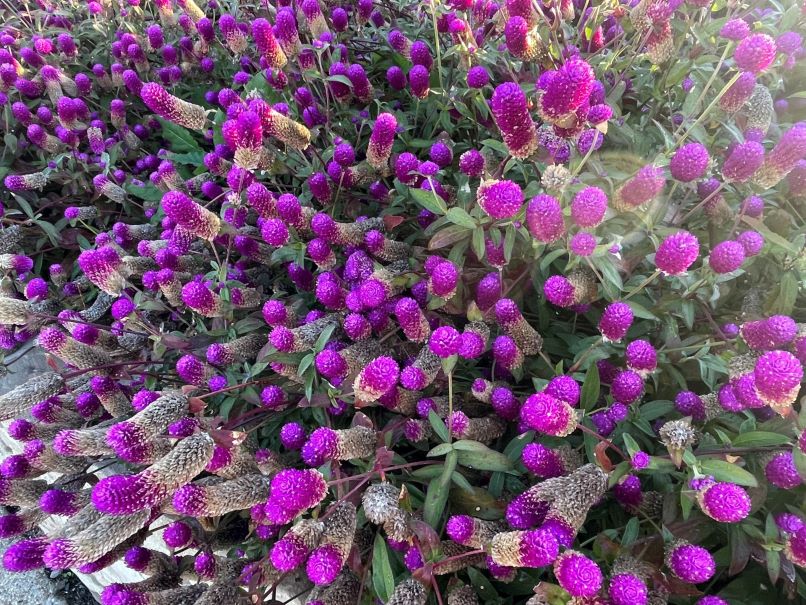Gomphrena: The Heat-Loving Showstopper for Your Garden
Searcy, Ark. –
I have become smitten in the last few weeks with a cool plant. It appears to be tough
and in full bloom in the hot dry weather we are experiencing. I saw it last week
at the Botanical Garden of the Ozarks and was mesmerized by it. There is another
glorious planting of it at the new Searcy First Security Bank Technology Center in downtown Searcy. Here’s a few photos of it but I encourage you to do a
drive by on Race Street and you will see what I am talking about.
Center in downtown Searcy. Here’s a few photos of it but I encourage you to do a
drive by on Race Street and you will see what I am talking about.
What is Gomphrena?
It’s gomphrena! This is a tough plant that likes really high temperatures. Sometimes called globe amaranth, it produces flowers from early summer to fall frost.
Unique Features of Gomphrena Flowers
The flowers look a lot like clovers, seem to last forever and have a straw-like texture. The flower heads are bracts, which are leaves resembling petals. The small, inconspicuous flowers are noticeable only when the yellow stamens poke out. Flower colors range from white to purple and red.
Botanical Background and Garden Success
Gomphrena is known botanically as Gomphrena globosa. It has relatively few pest problems. Because of its strong garden performance, Gomphrena has been chosen as a Mississippi Medallion winner twice in the past five years. The Mississippi Medallion plants are proven winners, like our Arkansas Diamond Plant program. There are pink, red, orange, purple and white gomphrena varieties, which have narrow deep green leaves and a compact or upright growth habit. Native to Central and South America, most cultivated varieties are from the species Gomphrena globosa, though there are other species grown as garden plants.
Award-Winning Varieties
All-Around Purple gomphrena won in 2008 in Mississippi too. This 2-foot-tall plant attracts loads of butterflies to its purple flowers all summer long. Fireworks gomphrena was a Mississippi Medallion selection in 2010. It is a large plant that can reach 4 feet tall. Its iridescent pink bracts feature yellow stamens resembling tiny firecrackers exploding.
Compact Varieties for Smaller Spaces
Gomphrena can be big, flowering annuals in the landscape. Some gomphrena are suitable for smaller garden or patio spaces. The Gnome series are compact plants that grow 10 to 12 inches tall and have white, pink and purple flowers. This compact selection makes a fine container plant or can be used as a border along a sunny path.
Growing Conditions for Gomphrena
Be sure to plant gomphrena in full sun. The plant will tolerate partial shade, but full sun produces better flowers.
Plants will thrive in well-drained planting beds. Once established in the spring, gomphrena will become somewhat drought-tolerant, but you will have to water it during extended dry periods.
Fertilization and Plant Care Tips
Gomphrena grows vigorously and should be fertilized at planting. Globe amaranth is an easy-to-grow annual that can be started from seed or nursery grown plants. It is a hot-weather plant, so allow the soil to warm before planting seeds or move transplants to the garden after the danger of frost is past. If seeding, soak the seed in water overnight before planting and plant a few extra seeds in each hill because germination is not usually high. It requires full sun and, once established, has moderate drought tolerance. Flowers cut for drying should be harvested when the blooms fully open, bunched and then hung upside down in a dark, well-ventilated room until dry.
Use a good, balanced, slow-release fertilizer, such as 14-14-14. Feed it with water-soluble fertilizer once every couple of weeks to encourage the plant to keep producing brightly colored flowers.
Deadheading and Pruning
Deadheading really isn’t necessary but do it if you feel the need to clean the plants up and remove spent flowers. You can do some other pruning to keep the plants looking neat.
Gomphrena as a Cut or Dried Flower
Gomphrena makes a great cut flower and has a long vase life. Cut stems early in the morning and pair with other flowers from your garden. Gomphrena also makes a good, dried flower. Tie flower stems into bunches and hang them upside down to dry in an airy room out of direct light. The everlasting flowers will retain their color and are great additions to craft projects and dried flower arrangements.
Ideas for Using Gomphrena in the Garden
According to the Proven Winners website:

- Use globe amaranth in a mixed border to fill in gaps for quick color.
- Grow gomphrena in a cutting garden in combination with other flowers for cutting such as black-eyed Susan, cosmos, dahlia, daisy,pinks, sunflower and zinnia.
- Plant in a cottage-style border alongside other traditional cottage garden flowers for bright color all summer long.
- Edge a pathway or border with globe amaranth for months of continuous color.
- Plant gomphrena in a dried cutting garden for use in everlasting arrangements and crafts. Other plants with everlasting flowers include statice, strawflower, love-in-a-mist (Nigella), poppy, lavender and globe thistle.
- Mass in a bed or border with other bedding plants such as petunias, calibrachoa, lobelia, marigold, coleus and salvia.
- Attract butterflies and other insect pollinators by planting gomphrena with other pollinator attracting plants such as ageratum, pentas, milkweed and lantana.
- Combine a compact gomphrena variety as a filler element in a hanging basket or window box in combination with a focal plant such as lantana and a vining plant such as sweet potato vine for a “thriller, filler, spiller” effect.
Companion Planting Suggestions
Try companion planting gomphrena with lantana, melampodium and rudbeckia. It also looks great with Diamond Frost euphorbia.
Yes, I know we are knocking on Halloween’s door, and it is too late to plant but the gomphrena is a showstopper this time of year. But it is never too early to plan for springtime planting and this one needs to be on your list.
By Sherri Sanders
County Extension Agent - Agriculture
The Cooperative Extension Service
U of A System Division of Agriculture
Media Contact: Sherri Sanders
County Extension Agent - Agriculture
U of A Division of Agriculture
Cooperative Extension Service
2400 Old Searcy Landing Road Searcy AR 72143
(501) 268-5394
ssanders@uada.edu
The Arkansas Cooperative Extension Service is an equal opportunity institution. If
you require a reasonable accommodation to participate or need materials in another
format, please contact your County Extension office (or other appropriate office)
as soon as possible. Dial 711 for Arkansas Relay.
Pursuant to 7 CFR § 15.3, the University of Arkansas System Division of Agriculture
offers all its Extension and Research programs and services (including employment)
without regard to race, color, sex, national origin, religion, age, disability, marital
or veteran status, genetic information, sexual preference, pregnancy or any other
legally protected status, and is an equal opportunity institution.